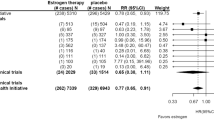Abstract
When evaluating whether the use of a particular method of contraception is associated with an increased or decreased risk of cervical cancer, it is important to be aware of the epidemiological factors which might lead to incorrect conclusions. After careful consideration of the issues, and examination of the available data, it is concluded that women who use oral contraceptives are possibly at increased risk of invasive cervical cancer; users of barrier methods probably have a decreased risk (although the protective effect may differ between the various types of barrier method); and that users of other methods of contraception do not have an altered risk.
Resumé
Lorsqu'on évalue si l'utilisation d'une méthode particulière de contraception est associée à une augmentation ou à une diminution du risque de cancer du col, il importe de tenir compte du fait que les facteurs épidémiologiques peuvent amener à tirer des conclusions erronées. Après avoir convenablement examiné ces questions et les données disponibles, il est permis de conclure que les femmes qui utilisent les contraceptifs oraux sont peut-être plus exposées au risque de cancer cervical invasif; que les utilisatrices des méthodes de barrière le sont probablement moins (encore que l'effet de protection puisse varier d'un type de méthode à l'autre), et que les risques ne sont en rien modifiés dans le cas des femmes qui font appel à d'autres méthodes contraceptives.
Resumen
Al evaluarse si la utilización de un método en particular de anticoncepción está asociado a un aumento o a una disminución del riesgo de cáncer de cuello, es necesario tener en cuenta que los factores epidemiológicos pueden llevar a extraer conclusiones erróneas. Tras considerar cuidadosamente estas cuestiones y los datos disponibles, se puede llegar a la conclusión de que las mujeres que utilizan anticonceptivos orales corren posiblemente un riesgo mayor de cáncer cervical invasivo; que las usuarias de métodos de barrera probablemente corran un riesgo menor (si bien el efecto de protección puede variar de un tipo de método a otro), y que los riesgos no se modifican en absoluto entre las mujeres que utilizan otros métodos anticonceptivos.
Similar content being viewed by others
References
Swann, S.H. and Petitti, D.B. (1982). A review of problems of bias and confounding in epidemiologic studies of cervical neoplasia and oral contraceptive use.Am. J. Epidemiol.,115, 10–18
WHO Collaborative Study of Neoplasia and Steroid Contraceptives (1985). Invasive cervical cancer and combined oral contraceptives.Br. Med. J.,290, 961–965
Brinton, L.A., Huggins, G.R., Lehman, H.F. et al. (1986). Long-term use of oral contraceptives and risk of invasive cervical cancer.Int. J. Cancer,38, 339–344
LaVecchia, C., Decarli, A, Fasoli, M. et al. (1986). Oral contraceptives and cancers of the breast and of the female genital tract. Interim results from a case-control study.Br. J. Cancer,54, 311–317
Parazzini, F., LaVecchia, C., Negri, E. and Maggi, R. (1990). Oral contraceptive use and invasive cervical cancer.Int. J. Epidemiol.,19, 259–263
Vessey, M.P., Lawless, M., McPherson, K. and Yeates, D. (1983). Neoplasia of the cervix uteri and contraception: a possible adverse effect of the pill.Lancet,2, 930–934
Beral, V., Hannaford, P. and Kay, C. (1988). Oral contraceptive use and malignancies of the genital tract.Lancet,2, 1331–1335
Andolsek, L., Kovacic, J., Kozuh, M. and Litt, B. (1983). Influence of oral contraceptives on the incidence of premalignant lesions of the cervix.Contraception,28, 505–519
Stern, E., Forsythe, A.B., Youkeles, L. et al. (1977). Steroid contraceptive use and cervical dysplasia: increased risk of progression.Science,196, 1460–1462
Peters, R.K., Thomas, D., Hagan, D.G., Mack, T.M. and Henderson, B.E. (1986). Risk factors for invasive cervical cancer among Latinas and non-Latinas in Los Angeles County.J. N. C. I.,77, 1063–1077
Ebeling, K., Nischan, P. and Schindler, C. (1987). Use of oral contraceptives and risk of invasive cervical cancer in previously screened women.Int. J. Cancer,39, 427–430
Celentano, D.D., Klassen, A.C., Weisman, C.S. and Rosenhein, N.B. (1987). The role of contraceptive use in cervical cancer: The Maryland Cervical Cancer Case-Control Study.Am. J. Epidemiol.,126, 592–604
Irwin, K.L., Rosero-Bixby, L., Oberle, M.W. et al. (1988). Oral contraceptives and cervical cancer risk in Costa Rica. Detection bias or causal association?J. Am. Med. Assoc.,259, 59–64
Slattery, M.L., OverallJr., J.C., Abbott, T.M., French, T.K., Robison, L.M. and Gardner, J. (1989). Sexual activity, contraception, genital infections, and cervical cancer: support for a sexually transmitted disease hypothesis.Am. J. Epidemiol.,130, 248–258
Brinton, L.A., Reeves, W.C., Brenes, M.M. et al. (1990). Oral contraceptive use and risk of invasive cervical cancer.Int. J. Epidemiol.,19, 4–11
Wright, N.H., Vessey, M.P., Kenward, B., McPherson, K. and Doll, R. (1978). Neoplasia and dysplasia of the cervix uteri and contraception: a possible protective effect of the diaphragm.Br. J. Cancer,38, 273–279
Fasal, E., Simmons, M.E. and Kampert, J.B. (1981). Factors associated with high and low risk of cervical neoplasia.J. N. C. I.,66, 631–636
Parazzini, F., Negri, E., LaVecchia, C. and Fedele, L. (1989). Barrier methods of contraception and the risk of cervical neoplasia.Contraception,40, 519–530
Hildesheim, A., Brinton, L.A., Mallin, K. et al. (1990). Barrier and spermicidal contraceptive methods and risk of invasive cervical cancer.Epidemiology,1, 266–272
WHO Collaborative Study of Neoplasia and Steroid Contraceptives (1986). Depot-Medroxyprogesterone acetate (DMPA) and cancer: Memorandum from a WHO Meeting.Bull. WHO,64, 375–382
Thomas, D.B., Molina, R., Cuevas, H.R. et al. (1989). Monthly injectable steroid contraceptives and cervical carcinoma.Am. J. Epidemiol.,130, 237–247
Author information
Authors and Affiliations
Rights and permissions
About this article
Cite this article
Hannaford, P.C. Cervical cancer and methods of contraception. Adv Contracept 7, 317–324 (1991). https://doi.org/10.1007/BF02340177
Received:
Accepted:
Issue Date:
DOI: https://doi.org/10.1007/BF02340177




